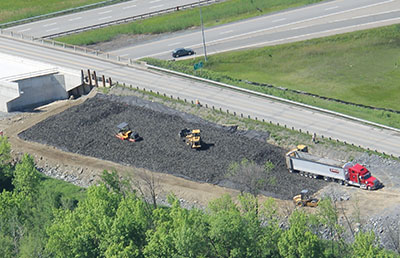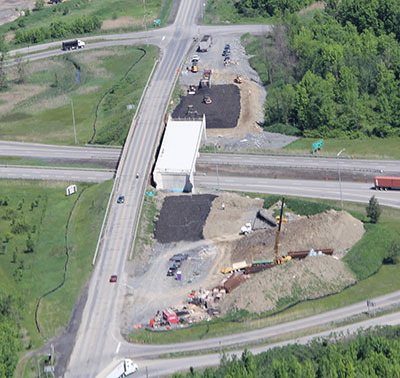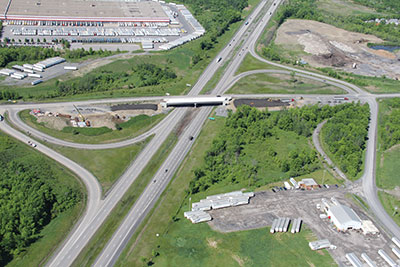
Features
Projects
Roads & Paving
Tire Derived Aggregate
MTO tests recycled tires as fill for embankment construction
June 11, 2014 By Andrew Macklin
The Hagersville Tire Fire in February of 1990 provided a rude awakening for the Ontario Ministry of Environment.
The Hagersville Tire Fire in February of 1990 provided a rude awakening for the Ontario Ministry of Environment. The Tyre King tire disposal yard, which housed an estimated 14 million tires at the time of the blaze, burned for 17 days as firefighters from 11 different fire departments battled the blaze around the clock.
The Ministry worked for several years to discover the best solution for dispersing the large volume of used tires being disposed of by Ontarians each year. But the bigger challenge was to figure out a way to find alternative uses for the recycled rubber, solutions that would have practical applications across the province.
 |
|
| Trucks used rolling floors to distribute the TDA, the piles were dozed into place, and then the area was rolled for maximum compaction. Advertisement
|
In 2008, the Ministry created Waste Diversion Ontario to tackle the issue of figuring out the best way to reuse and/or recycle the used tires, which by this point were being scrapped at a rate of 10 to 12 million per year. Out of the WDO was born the Ontario Tire Stewardship, which was officially set up in August of 2009. Under immense political pressure to find a solution for the tire problem, the OTS began looking at the many uses for shredded tires.
“The Ministry of Transportation conducted a jurisdictional search to understand where shredded tire had been used before,” said Tony Sangiuliano, foundations engineer for the Ontario Ministry of Transportation.
While several examples from the U.S. emerged during the search, there was also one from New Brunswick that caught MTO’s attention. In the small town of St. Stephen, 1.4 million scrap tires had been used as tire derived aggregate in a slope stability retrofit to help lighten the load.
The shredded tires used involved shreds that were between ½ to 18 inches in length. The shreds were found to have strong engineered properties. Voids in the compacted shreds allowed for free draining, and the rubber absorbed vibrations well. Also, the TDA exhibited very strong thermal insulation properties, with seven times the thermal resistance of regular fill.

|
|
| A close up look at the full construction site, next to the site of the TDA embankment.
|
The use of TDA is governed by ASTM standard D6270-08, which outlines solutions for addressing the issues surrounding the use of shredded tire fill. Issues surrounding internal heating had to be addressed, which involves a restriction in the height of the compacted TDA, since it can combust, and the corrosion of the steel in the tires can still happen. But the MTO determined that if they mitigated the thickness of the TDA used in the embankment fill, and there was a way to capture any chemical pollution as a result of using recycled rubber, then the TDA could be a real solution for using recycled tires as a fill substitute.
The immediate challenge for MTO was to find a suitable site to test the tire derived aggregate.
“We wanted to incorporate TDA into an upcoming project, something we were starting in the next 12 months,” said Sangiuliano. “We wanted a site that would require substantial quantities to be used but not on a major artery. We also wanted to be sure that it was a site where native soils would not be an issue, where we were confident in the subsurface soil conditions. We also understood that the area couldn’t contain any environmental sensitivities.”
After approaching different regions of the province to look for a location, a fit for the TDA project was found in eastern Ontario as part of an embankment being built for a new bridge across Highway 401 at Boundary Road just east of Cornwall. The project met all of the criteria outlined by the Ministry during its search for a suitable site.
The original design was completed with involvement from AECON Construction. An addendum was added to the original project plan, which included putting an impervious seal on all sides of the TDA to minimize water and air movement in the fill. There was extensive instrumentation monitoring equipment included in the project to help monitor the TDA at all phases of the construction process as well as for post evaluation of the TDA’s performance. This was necessary not only because it was the first of its kind in Ontario, but also in order to analyze any iron and manganese that leeched out of the tires. The leak potential was not extreme enough to violate the province’s water protection policy, but the MTO still needed to collect data on any leaking that occurred.
 |
|
| A full aerial view of the intersection of Highway 401 at Boundary Road east of Cornwall, Ont. near the border with Quebec.
|
The fill area for the TDA for the project was 4,000 cubic metres. For every cubic metre of fill, 100 shredded tires are required. As a result, the Boundary Road project required 400,000 shredded tires at a weight of 3,000 tonnes. The original processing plant involved with the project was from nearby Cornwall, but they could not meet the supply needed for the project. That added to the logistics cost of the project, as the contracted supplier would be in Brantford instead, located approximately 535km from the site. Also the maximum production level for the contractor, Liberty Tire Recycling, was 100 tons/day, which meant it took six weeks to provide the full amount of TDA.
Once the entire supply of spec TDA was received, the construction process went without any major issues. The trucks used rolling floors to distribute the TDA, the piles were dozed into place, and then the area was rolled for maximum compaction. The clay bed and geotextile cover were used to encase the TDA within the designed framework, and the settlements of the material were quicker than originally expected.
In October of 2012, the embankments were built – the area was open to the public one month later. The final elements of the project were to be completed this spring, with the deadline set for the end of May.
After 18 months of closely monitoring the TDA, there have been no internal heating issues reported. There has been a minor leeching of benzene from the binder, but not at an amount that raises any concern.
Now that the use of TDA has been successful, MTO is looking to the Ministry of the Environment for an exemption that will allow MTO to use tire derived aggregate on additional road construction sites. The use of TDA lowers the amount of aggregates needed on road construction projects and reduces the stockpile of tire in depots and landfills across the province. The associated costs of using TDA are significantly higher than that of virgin granular A, with TDA costing approximately $0.55 per ton. However, it is the cheapest of the current lightweight fill alternatives available on the market, according to Sangiuliano.
With site monitoring expected to continue for at least another 18 months, the Ontario Ministry of Transportation should be able to collect the relevant data needed to plead its case for increased use of tire derived aggregate in additional projects across the province. It also might provide the solution needed to reduce scrap tires stored in unsafe conditions across the rest of the country.
Print this page